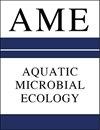Near-benthic coral reef picoplankton vary at fine scales decoupled from benthic cover
IF 1.1
4区 环境科学与生态学
Q3 ECOLOGY
引用次数: 0
Abstract
ABSTRACT: Seawater microorganisms impact ecological and biogeochemical cycling on coral reefs and are sensitive indicators of ecosystem status. Microbialization, a shift towards trophic collapse and resultant high microbial biomass, is a global concern on coral reefs. Indeed, macroorganisms can influence microbial processes and community composition on reefs, which is best understood as increased macroalgae resulting in copiotrophic microbial growth and oxygen reduction. Whether or not smaller-scale changes in macroorganisms influence the overlying seawater microbial communities is largely unknown. Here, we assessed seawater microorganisms across 3 coral reefs to understand their connection to reef site and within-reef benthic characteristics. At 3 coral reefs in St. John, US Virgin Islands, we collected 60 ml seawater samples 2 cm above the seafloor, spaced 2 m apart in a grid pattern, and assessed bacterial and archaeal communities via sequencing of small subunit ribosomal RNA genes. Benthic cover within 1 m of each sample was determined at 10 cm resolution through photogrammetry. Our results reveal that overall reef site overwhelmingly shapes microbial community structure, while within-reef benthic cover surrounding sample locations has minimal influence. However, ecospheres as areas that reflect the small-scale effects of benthic cover directly under each sample, significantly explain as much as 12.1% of within-reef microbial variation and may even outweigh variation attributable to reef site alone. These findings provide new insights into fine-scale spatial variability in reef seawater microbiomes that are crucial for the use of microorganisms as indicators of microbialization and coral reef health.近底栖珊瑚礁微浮游生物在与底栖覆盖物脱钩的精细尺度上各不相同
摘要:海水微生物影响珊瑚礁的生态和生物地球化学循环,是生态系统状况的敏感指标。珊瑚礁微生物化是一个全球关注的问题,微生物化是指珊瑚礁营养崩溃并导致微生物生物量过高。事实上,大型生物可以影响珊瑚礁上的微生物过程和群落组成,最好的理解是大型藻类的增加导致共养微生物的生长和氧气的减少。宏观生物较小范围的变化是否会影响上层海水微生物群落,目前还不清楚。在此,我们对 3 个珊瑚礁的海水微生物进行了评估,以了解它们与珊瑚礁地点和礁内底栖生物特征之间的联系。在美属维尔京群岛圣约翰的 3 个珊瑚礁上,我们采集了 60 毫升的海水样本,样本距离海底 2 厘米,以网格模式间隔 2 米,并通过小亚基核糖体 RNA 基因测序评估了细菌和古细菌群落。通过摄影测量法,以 10 厘米的分辨率确定了每个样本 1 米范围内的底栖动物覆盖率。我们的研究结果表明,整个珊瑚礁地点对微生物群落结构的影响最大,而样本地点周围的礁内底栖覆盖物的影响则微乎其微。然而,生态圈作为直接反映每个样本下底栖生物覆盖的小尺度影响的区域,可以显著解释多达 12.1%的礁内微生物变异,甚至可能超过仅由礁石地点引起的变异。这些发现为研究珊瑚礁海水微生物群的细尺度空间变异性提供了新的视角,这对于利用微生物作为微生物化和珊瑚礁健康的指标至关重要。
本文章由计算机程序翻译,如有差异,请以英文原文为准。
求助全文
约1分钟内获得全文
求助全文
来源期刊

Aquatic Microbial Ecology
环境科学-海洋与淡水生物学
CiteScore
3.30
自引率
0.00%
发文量
8
审稿时长
3.0 months
期刊介绍:
AME is international and interdisciplinary. It presents rigorously refereed and carefully selected Research Articles, Reviews and Notes, as well as Comments/Reply Comments (for details see AME 27:209), Opinion Pieces (previously called ''As I See It'') and AME Specials. For details consult the Guidelines for Authors. Papers may be concerned with:
Tolerances and responses of microorganisms to variations in abiotic and biotic components of their environment; microbial life under extreme environmental conditions (climate, temperature, pressure, osmolarity, redox, etc.).
Role of aquatic microorganisms in the production, transformation and decomposition of organic matter; flow patterns of energy and matter as these pass through microorganisms; population dynamics; trophic interrelationships; modelling, both theoretical and via computer simulation, of individual microorganisms and microbial populations; biodiversity.
Absorption and transformation of inorganic material; synthesis and transformation of organic material (autotrophic and heterotrophic); non-genetic and genetic adaptation; behaviour; molecular microbial ecology; symbioses.
 求助内容:
求助内容: 应助结果提醒方式:
应助结果提醒方式:


